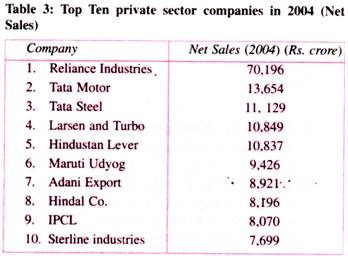India is a capitalistic biased mixed economy.
It is needless to say, what important role private sector plays for the economic development of the country.
Contributions of Private Sector are Listed Below:
1. Most Important Sector:
In-spite of huge progress of the public sector during the plan period, the importance of private sector is tremendous in the India economy. On the basis of the latest data available for the country’s industrial development as given in the table -1, the number of private sector companies in 2001- 02 was 1, 10, 634 in compare to the total number companies of 1,28,549. In other way 86.1% of the total companies were under the control of private sector in compare to only 11.67o companies under public sector.
2. Employment Generation:
Private sector plays a dominant role for generating employment opportunities inside the country. A huge number of large scale, small scale, cottage scale units are under the control of private sector. It proves that small scale and cottage scale industries contribute four times more employment in compare to large scale industries. According to 2001-02 statistics, as far as employment is concerned, the share of private sector was 51.2% against 44.3% of the public sector. This is shown in the table 2.
3. Helpful for Development:
According to Schumpeter peter private sector plays a dominant role in economic development. It enhances the process of industrialisation. All the private entrepreneurs are worked for profit motive. They actually played a leading role for the introduction of new commodities, new techniques of production, new plants equipment’s and machineries. Private entrepreneur has innovative ideas and always modifies the total method of production. After the introduction of new industrial policy in 1991, private sector leads a vital role in country’s industrial development.
4. Contribution to Agriculture:
India is an agro based economy. The share of agriculture and its allied activities like fishing, poultry, cattle rearing, animal husbandry, dairy farming etc. to the national income is nearly 22%. On the other hand, about 60% of the total working population is engaged in this area. Hence, this large agriculture sector is controlled by the private sector.
5. Contribution to Industry:
ADVERTISEMENTS:
According to 1956 resolution, “industries producing intermediate goods and machines can be set up in the private sector.” A good number of ultra modern industries are constructed under the control of private sector. This includes several consumers’ good industries like sugar industry, edible oil industry, textile industry, paper industry, spice industry and fast food or semi-finished food industries.
Even in the sphere of capital goods, iron and steel heavy engineering, chemical, motors etc. private sector plays a dominant role for their development. In the post liberalisation phase (after introduction of New Industrial Policy, 1991), the working of few private industries became huge. Table 3, shows the net sales of 10 top giant private sector industries in India during 2004.
6. High Potentiality:
Most of the small scale and cottage scale industries are using labour intersine technologies, they create huge employment opportunities. These industries are owned by private sector. About 80% of the total working forces are employed in either organized or unorganized private sector units. Private sector contributes about three-forth of the country’s national income. Moreover, this sector also plays a vital role to increase gross domestic saving (CDS) and gross domestic capital formation'(GDCF) within the economy.


